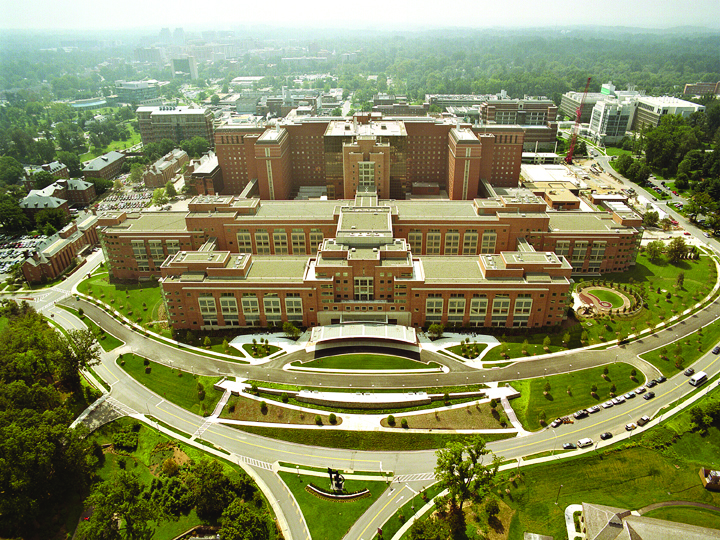
Contributed by Wikimedia Commons
The National Institutes of Health has awarded a $2.8 million grant to an NC State professor to further her research investigating cellular mechanisms in left-right asymmetric organ formation and its potential benefits for the future of biological mechanisms.
Nanette Nascone-Yoder, a professor of developmental biology and lead investigator on the project, said the focus of the project is the origins of anatomical left-right asymmetry in organs.
“When you say the Pledge of Allegiance, you put your hand over your heart on the left side of your body, and that’s because the heart is actually a left-right, asymmetric organ with left and right chambers and vessels that do different things right,” Nascone-Yoder said. “So I’m interested in understanding where that comes from during embryonic development — what is it that causes each organ to assume a specific left-right asymmetric shape?”
Nascone-Yoder said her research is beneficial to understanding, and hopefully someday preventing, certain common birth defects such as heart defects and intestinal malrotation.
She said a crucial part of understanding left-right asymmetry lies within the behaviors and properties of cells.
“We want to understand, and at the level of cell biology, in terms of the behaviors and properties of the cells on the left side versus the right side,” Nascone-Yoder said. “And we want to understand, in collaboration with Julio Belmonte, how the physical forces that are created by the cells actually lead to the higher level visible curvature.”
Julio Belmonte, an assistant professor of physics and one of the coinvestigators on the project, said this is the first time left-right asymmetry is being modeled using a multicellular, individual, multiscale model.
Belmonte is responsible for the computational simulations and mathematical models of the project. He said that the use of computational models is essential for recreating different outcomes and interactions of cells.
“I use a simulation software to model the cells and their interactions with one another,” Belmonte said. “The simulation results depend on the rules and the parameters that you give to the cells; based on them, cells will start interacting and give rise to different outcomes.”
Belmonte said while they don’t precisely know what they are looking for, they can use the process of 2D and 3D modeling to test how specific parameters and behaviors lead to the stomach curvature they are looking for.
“The question is precisely, what are the combinations of cell properties and behaviors that drive the process?” Belmonte said. “We have some candidates. We know that cell adhesion is important and that cell intercalation is important, but cell polarization and tissue stiffening/softening may also play a role.”
Nascone-Yoder said a primary intent of their research is to investigate the origins of left-right asymmetry, particularly in the stomach.
“Our goal is to understand at multiple levels how organs become left, right and asymmetric. So we focus on the stomach, because the stomach is a straight tube that curves like it’s the simplest left-right asymmetry that the body forms,” Nascone-Yoder said. “And so we want to understand at the level of gene expression what’s different between the left side and the right side of the stomach.”
Nascone-Yoder emphasized that everything happening with organs is not singular. She said all parts of the body are working together in unison.
“In this universe, where we have gene expression and we have cells, it’s not happening in isolation, it’s happening in the context of forces,” Nascone-Yoder said. “And how does that affect the overall, larger scale tissues and organs? And to have that knowledge will be relevant to lots of different areas of science.”
With the implementation of the grant from the NIH, Nascone-Yoder said she has a few hypotheses that she’s focusing on.
“The stomach is made of multiple layers,” Nascone-Yoder said. “The grant is essentially trying to understand what each layer does on each side and how they interact with each other at different stages of development to ultimately create the final left, right, asymmetric shape.”
The grant given to Nascone-Yoder and Belmonte is set to last five years. Nascone-Yoder expressed excitement about what her research could accomplish beyond other organs than the stomach at the end of the grant period.
“I would be excited about taking what we’ve learned and applying it to other organs,” Nascone-Yoder said. “To be able to take the general concepts that we’ve learned and apply it to other tubular organs, I think, would be a tremendous next step.”
Nascone-Yoder said she hopes to provide insight into the development of left-right symmetry.
“At the end of the grant, it would be amazing if we could tell a story about how the stomach curves,” Nascone-Yoder said. “I think that would be a tremendous advance in our ability to understand how, not only left-right asymmetry develops, but also just how organs form in general.”
Belmonte expressed similar sentiments about their research.
“Maybe in the very long term, our study may be a little step towards understanding exactly why this abnormal left-right asymmetry happens, not only in the stomach but also in other organs,” Belmonte said. “Because if we not only know the genetic side of it, but also the cell mechanisms involved in the process, that may be a way to, in the future, discover different ways to treat abnormal left-right development or prevent it from happening.”